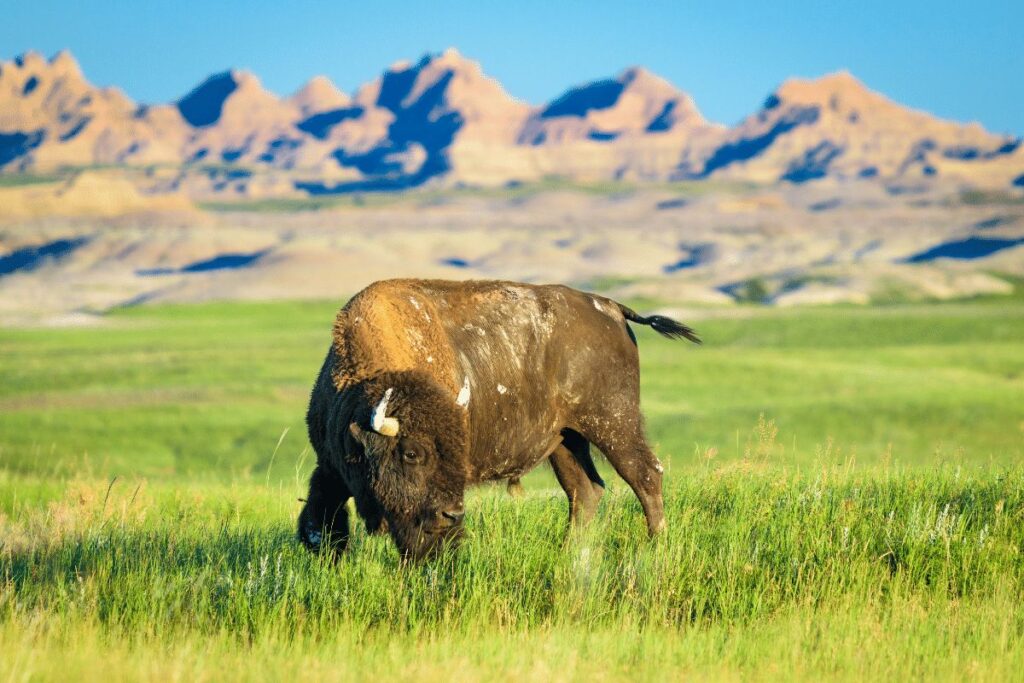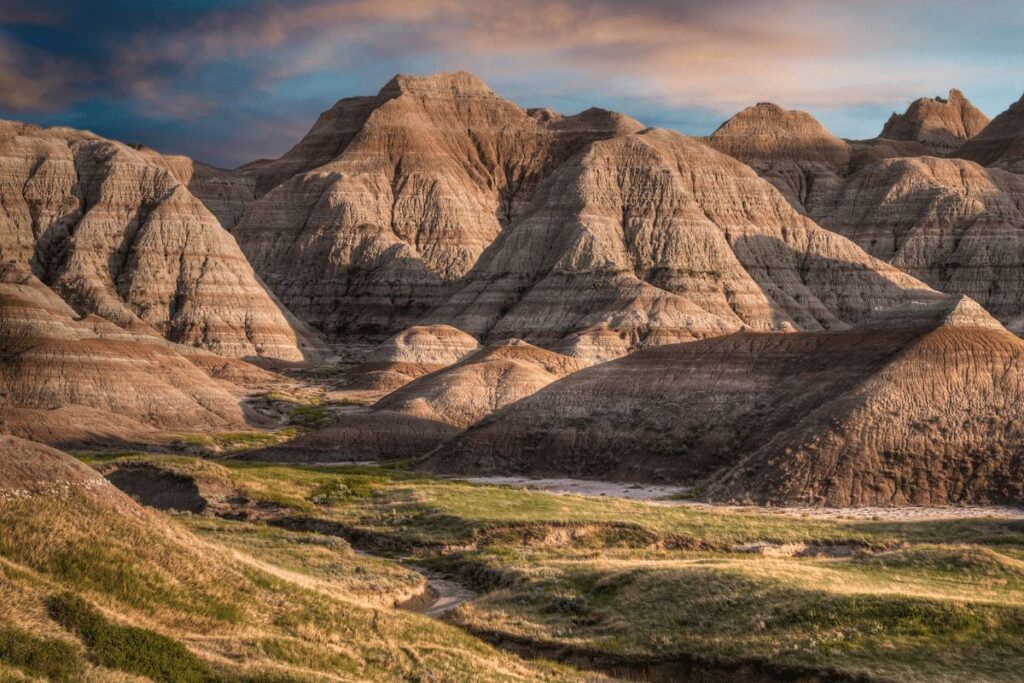Discover 10 Animals in Badlands National Park seen on hikes. Dive into a photo journey with bison, mountain lions & more. Experience nature's magic!
Get ready for an unforgettable journey through the heart of Badlands National Park, where the wild meets the wanderer.
On our hikes, we stumbled upon a mosaic of wildlife, from the mighty bison reigning supreme over the plains, to the secretive mountain lion watching from the shadows.
Each encounter felt like unwrapping a gift from Mother Nature herself. Armed with a camera and a sense of wonder, we’ve documented these thrilling moments just for you.
So, whether you’re an avid animal lover or just someone looking for a thrilling virtual escape, this article promises a rollercoaster of emotions and awe-inspiring visuals.
Buckle up and let’s embark on this wild ride through the Badlands, with every photo serving as a passport stamp to nature’s most enchanting corners.
Bison
The bison, sometimes colloquially known as buffalo, stands as a majestic emblem of North America’s rich wilderness. They are the continent’s largest mammals and exude a raw sense of power and gravitas.
At a glance, their heavy head, broad shoulders, and shaggy dark-brown coat make them instantly recognizable. Two curved, sharp horns lend them an air of authority, making them a captivating sight on the grasslands.
In Badlands National Park, these magnificent creatures primarily roam the park’s sprawling prairies and open grasslands.
The Castle Trail, with its vast stretch of 10 miles, is often a good spot to witness herds of bison grazing or lounging lazily under the vast sky.
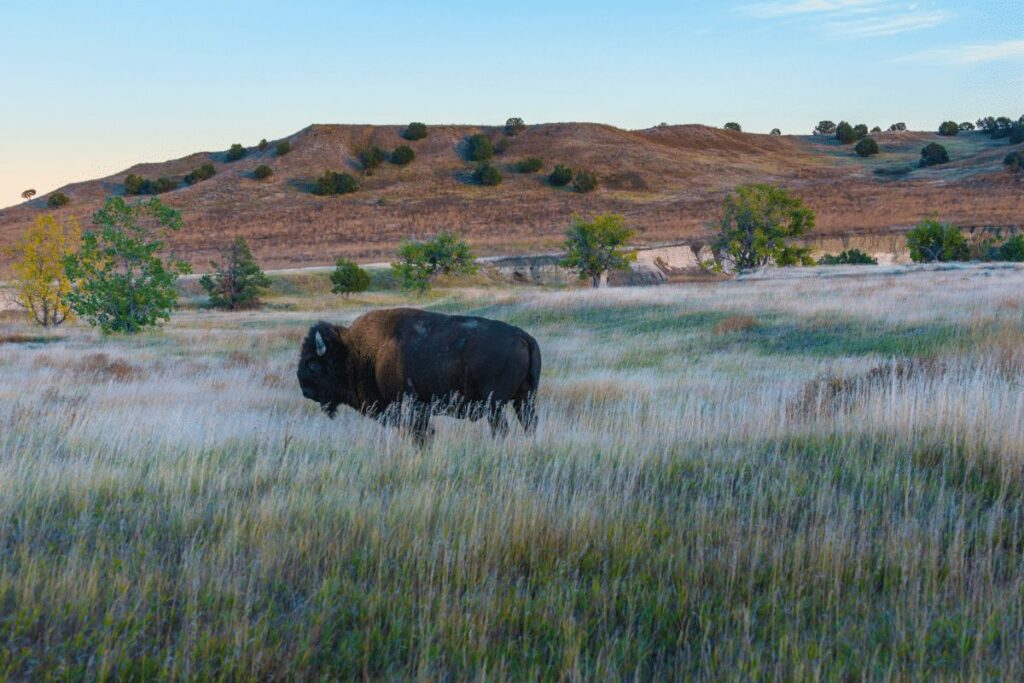
Interestingly, bison have a vital role in the ecosystem. They graze heavily on grasses, promoting the growth of newer shoots and preventing overgrowth. This grazing pattern ensures other smaller animals and birds have suitable habitats.
For those yearning for a closer experience, the Sage Creek Wilderness Area is another hotspot for bison sightings. But always remember: while they might appear calm and docile, bison are wild animals.
It’s crucial to view them from a distance and never approach. They are surprisingly fast for their size and can run up to 35 miles per hour when provoked.
An exciting tidbit about bison is their historic significance. Once, millions of bison roamed the plains, but by the late 1800s, they were near extinction due to overhunting and habitat loss. Conservation efforts, including those in national parks like Badlands, have been pivotal in reviving their populations.
So, next time you’re hiking through the Badlands, keep an eye out for these magnificent beasts. Their presence is not just an ode to the park’s natural beauty but also a testament to conservation success stories.
Bighorn sheep
Bighorn sheep are a sight to behold in Badlands National Park. Easily distinguished by their robust, spiral horns — a signature trait in males — these sheep wear a coat that ranges from brown to grayish, allowing them to blend seamlessly into the rocky terrain of the park.
Primarily found on the steeper cliffs and outcroppings of Badlands, they have evolved to be agile climbers, able to navigate rocky terrains with a grace that belies their size.
Their hooves are specially adapted for this, with concave undersides that provide grip even on the slipperiest of slopes. It’s no wonder then that the Notch Trail, with its vantage points and challenging terrains, often offers glimpses of bighorn sheep nimbly ascending or descending the cliffs.
One of the most enthralling spectacles involving bighorn sheep is their mating season battles. During this time, male sheep, or rams, engage in fierce head-butting contests to establish dominance and win over potential mates.
The sound of their horns clashing can be heard echoing across the park.
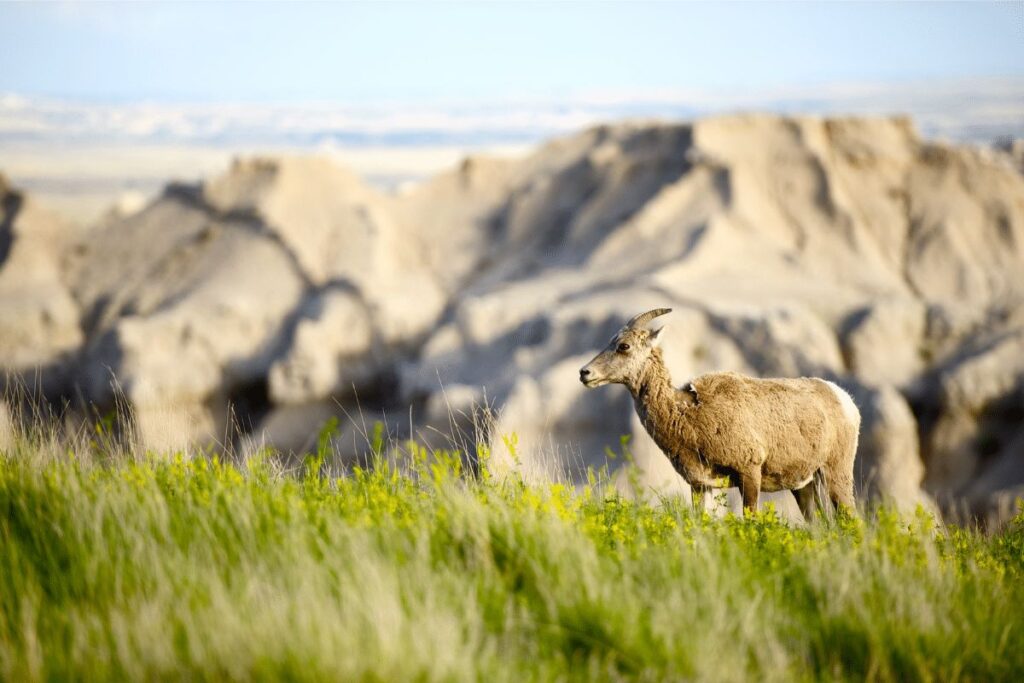
Bighorn sheep have not always had an easy time in the Badlands. Originally, they disappeared from the region in the 1900s due to overhunting and diseases introduced from domestic sheep.
It wasn’t until the 1960s that efforts were made to reintroduce them to the park, and today, they are once again a thriving testament to successful conservation efforts.
Beyond their captivating physical prowess and conservation story, bighorn sheep also play an integral role in the park’s ecosystem. Their grazing habits help maintain the health of local vegetation, ensuring a balanced and thriving environment for other species.
So, while wandering through the breathtaking landscapes of the Badlands, keep an eye on those rocky terrains; you might just spot a bighorn sheep expertly navigating its rugged home.
Pronghorn
Pronghorns, often lovingly referred to as “the prairie ghosts,” are an enchanting part of the Badlands National Park’s fauna. Distinguished by their sleek, tan bodies and white markings, pronghorns sport a pair of curious black horns, from which they derive their name.
Unlike other horned animals, pronghorns shed the outer sheath of their horns annually, a trait unique to this species.
Native to North America, pronghorns are built for speed. With their large eyes set high on their head, they have an expansive field of vision, a useful adaptation for spotting predators across the open plains.
When it comes to escaping those threats, pronghorns hold the title of the second-fastest land animal, reaching speeds up to 55 miles per hour, outpaced only by the cheetah.
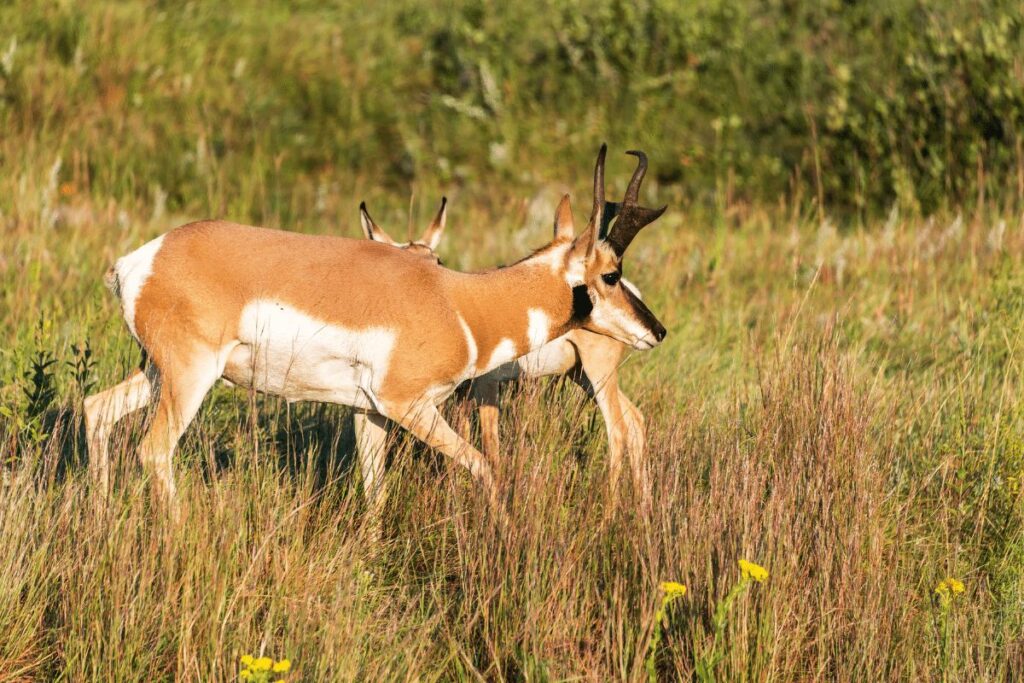
In Badlands National Park, these nimble creatures are often seen grazing on the vast grasslands or darting across the plains, their white rumps flashing in the sunlight. Trails like the expansive Castle Trail, which meanders through open grasslands, provide excellent opportunities to observe these swift animals in their natural habitat.
A lesser-known fact about pronghorns is their impressive migratory behavior. Some pronghorns migrate over vast distances, with certain populations traveling over 150 miles between their summer and winter habitats. This migration, one of the longest in North America, underscores their deep connection with the vast landscapes of the continent.
Though pronghorns are primarily grazers, their diet is diverse, and they occasionally browse on shrubs and other plants, adapting their feeding habits to the seasonal availability of food. This adaptability has ensured their survival in the sometimes harsh conditions of the Badlands.
As you traverse the rolling grasslands and undulating terrains of the Badlands, it’s worth pausing to appreciate the beauty of the pronghorns. Their grace, agility, and resilience embody the spirit of the American West.
Mule deer
Mule deer, named for their large, mule-like ears, are a staple of the Badlands National Park’s diverse ecosystem. These graceful animals sport a coat that’s typically a grayish-brown in winter, shedding to a reddish or tan hue during the summer months.
Their white rump patch and a small white tail with a black tip are distinctive features, making them easy to identify, especially against the rugged backdrop of the park.
These deer are well-suited to the varying terrains of the Badlands. Their large, bifurcated hooves are perfect for both the softer grounds of the grasslands and the rocky outcroppings that define much of the park’s topography.
Mule deer are often seen bounding across the landscape, showcasing their unique way of moving, known as “stotting” or “pronking,” where all four feet push off the ground simultaneously.
While they can be spotted on numerous trails, areas with a mix of open meadows and tree or shrub cover are ideal for catching a glimpse of mule deer.
Their crepuscular nature means they’re most active during dawn and dusk, making these times ideal for wildlife enthusiasts hoping for an encounter.
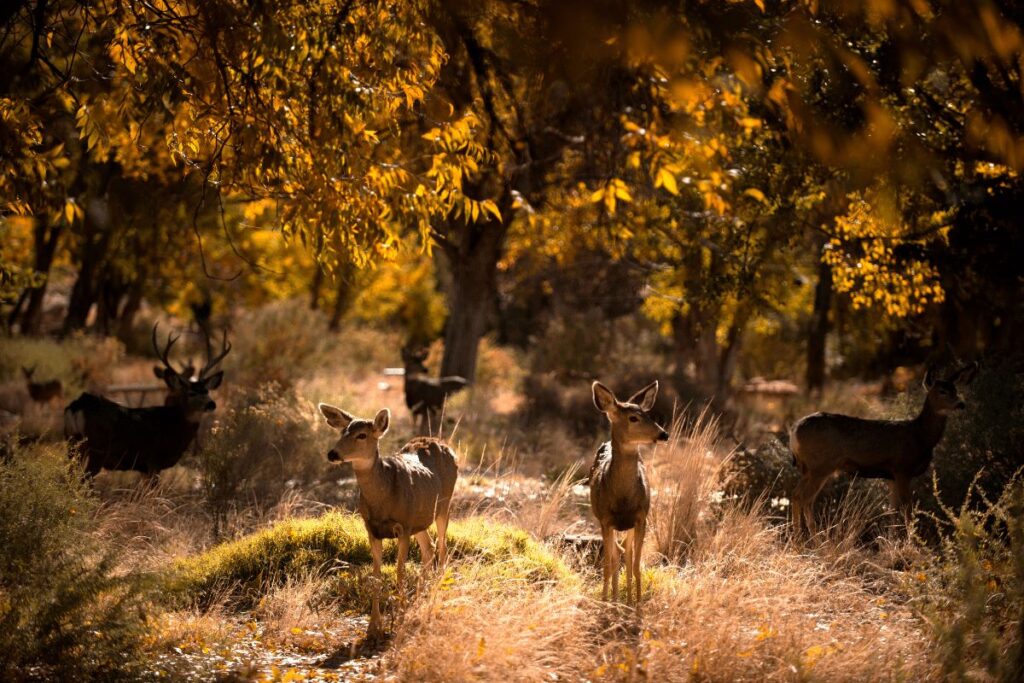
Mule deer are herbivores with a varied diet, feeding on a mix of grasses, shrubs, and even cacti, adapting their choices based on the season and availability. Their keen sense of hearing, thanks to those large ears, coupled with an acute sense of smell, helps them detect predators and stay safe in their natural habitat.
Their presence in the park, like other deer species, plays a vital role in the ecosystem. As primary consumers, they aid in plant control, ensuring a balance in the vegetation. Moreover, they are a key prey species for predators like mountain lions, ensuring a balanced food web.
As you meander through the trails and paths of the Badlands, watching a mule deer graze peacefully or leap with agile grace across the plains is truly a moment of connection with the park’s natural rhythm and beauty.
Whitetail deer
The white-tailed deer, with its iconic, bushy, white-flagged tail, is another cherished resident of the Badlands National Park. Smaller and more delicate in build compared to the mule deer, the white-tailed deer is characterized by its reddish-brown coat in the summer, which turns to a greyish-brown in the colder months.
When alarmed or on the move, they often raise their tail, displaying its white underside, a visual cue that’s easily recognizable even from a distance.
The habitats of the white-tailed deer within the park are more diverse. They tend to favor the edges of forests, grasslands, and even wetlands, making them slightly more adaptable to varying terrains than their mule deer counterparts.
This adaptability has given them a broader range across North America, making them one of the most widespread deer species on the continent.
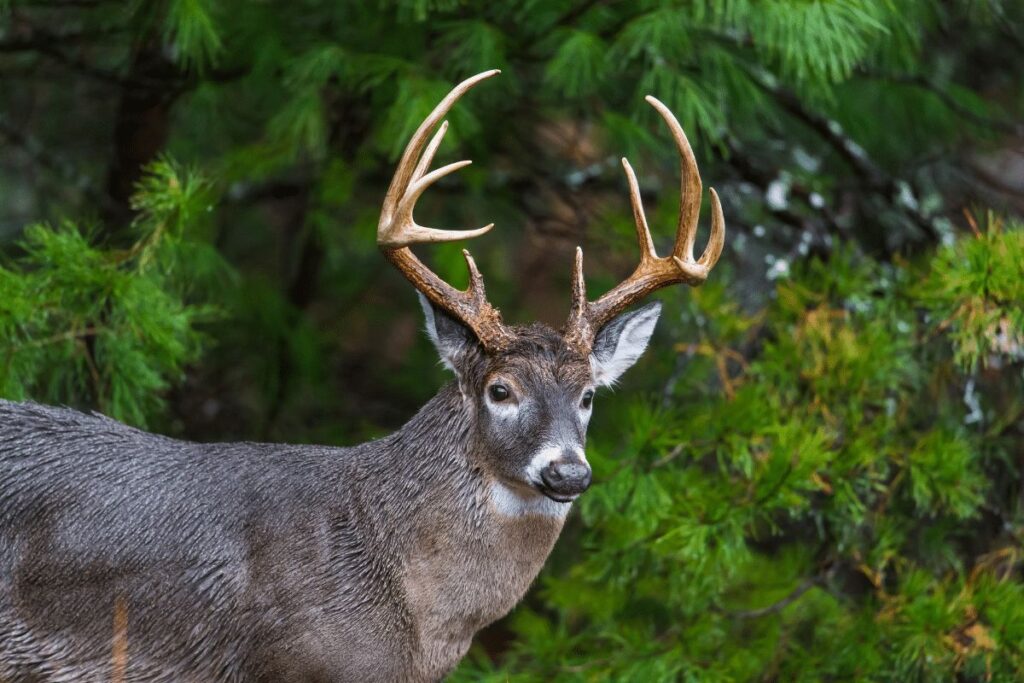
A quintessential moment in Badlands is watching a white-tailed deer gracefully leap over obstacles. Unlike the mule deer’s bounding stot, white-tails use a long, arched jump, which has been described as elegant and almost balletic. This agility, paired with their keen senses, makes them adept at evading potential predators.
Their diet is versatile. White-tailed deer are browsers, primarily feeding on leaves, shoots, and twigs. However, they won’t shy away from grasses, fruits, and nuts when they’re available. This diverse diet helps them thrive in various habitats and across seasons.
White-tailed deer also play a vital role in shaping the ecosystem of the park. By foraging on a variety of plants, they aid in seed dispersal, which promotes plant diversity. Moreover, as with the mule deer, they’re an essential prey item for larger predators, helping maintain the balance of the Badlands’ ecological dynamics.
On your journey through Badlands National Park, whether you’re traversing a grassy knoll or skirting the edge of a forested area, the sight of a white-tailed deer delicately moving through the landscape adds a touch of serenity and wonder to the experience.
Elk
The elk, sometimes called the wapiti, is one of the largest species within the deer family and an occasional visitor to Badlands National Park.
These majestic creatures carry an air of nobility, with males sporting impressive antlers that can span several feet. Their coats have a rich, earthy hue, with a lighter tan rump and darker legs and neck, offering a stunning contrast against the Badlands’ unique geology.
Elk prefer a range of habitats, from dense forests to open meadows. Within the Badlands, they can sometimes be found in grassy areas and near sources of freshwater, which they frequent for drinking and foraging.
Their presence in the park is more transient compared to other deer species, making any sighting an especially memorable event for wildlife enthusiasts.
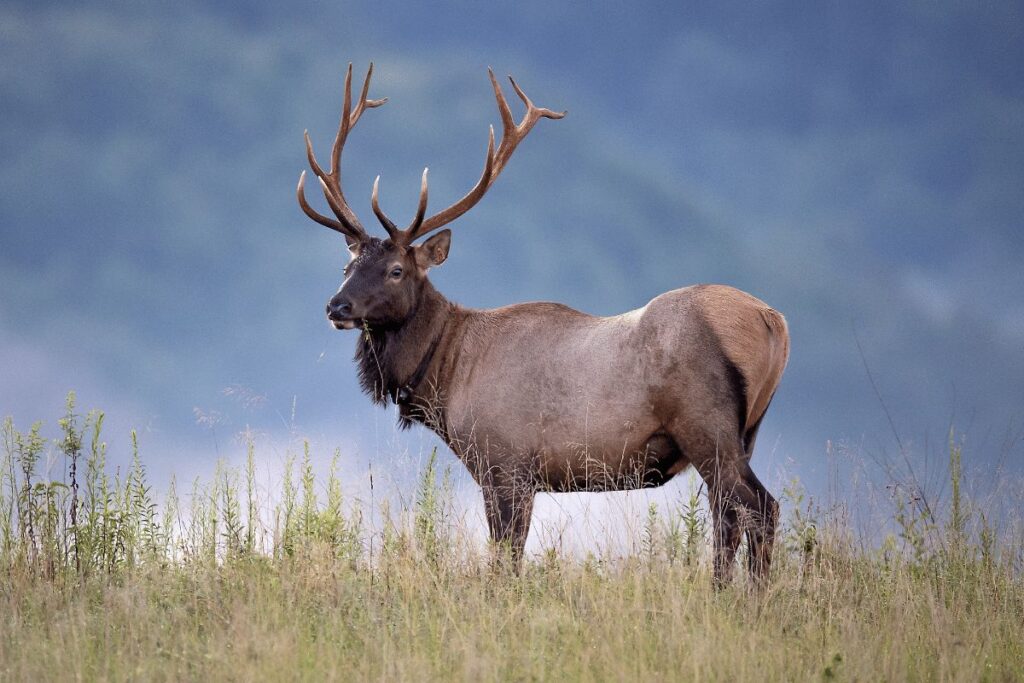
Renowned for their bugling calls, male elks produce this distinctive and haunting sound, particularly during the rutting season. It serves as both a call to potential mates and a warning to rival males.
If you’re fortunate enough, being serenaded by this call while amidst the park’s striking formations is an unparalleled experience.
Elk are herbivores with a penchant for grasses, plants, and leaves. Their large size means they require substantial amounts of food, often grazing for hours.
During winter months, when the vegetation is sparse, they’ll feed on shrubs and tree bark to sustain themselves.
Their migratory patterns are influenced by seasonal changes. Elk often move to higher elevations during warmer months and descend to valleys in colder months in search of food, making their movement patterns within the Badlands somewhat unpredictable.
In the broader ecosystem, elks play a dual role. Their grazing influences the landscape, promoting plant diversity.
Simultaneously, they are a vital food source for predators like wolves and mountain lions, ensuring a healthy balance within the food chain.
As you explore the vast expanse of Badlands National Park, spotting an elk is like finding a hidden gem. Their grace, combined with their size and those magnificent antlers, offers a breathtaking glimpse into the rich tapestry of life that thrives in this rugged landscape.
Swift fox
The swift fox, a diminutive yet sprightly inhabitant of the Badlands National Park, is a marvel of agility and adaptability. This petite creature, with its soft grayish coat and characteristically large ears, often roams the open expanses of the Sage Creek Wilderness Area.
Within this vast landscape, the swift fox creates intricate burrows, which are crucial for protection against both predators and the elements. These burrows, often dotting the more open areas of the park, become focal points of activity, especially during the early morning or late evening hours.
When it comes to sustenance, the swift fox is an opportunist. Its diet is impressively varied, with the fox foraging for small mammals, birds, and even certain insects.
On occasion, they might nibble on vegetation, revealing their omnivorous tendencies. The park’s grasslands, especially around areas like the Conata Basin, provide a buffet of sorts for these foxes, teeming with potential prey.
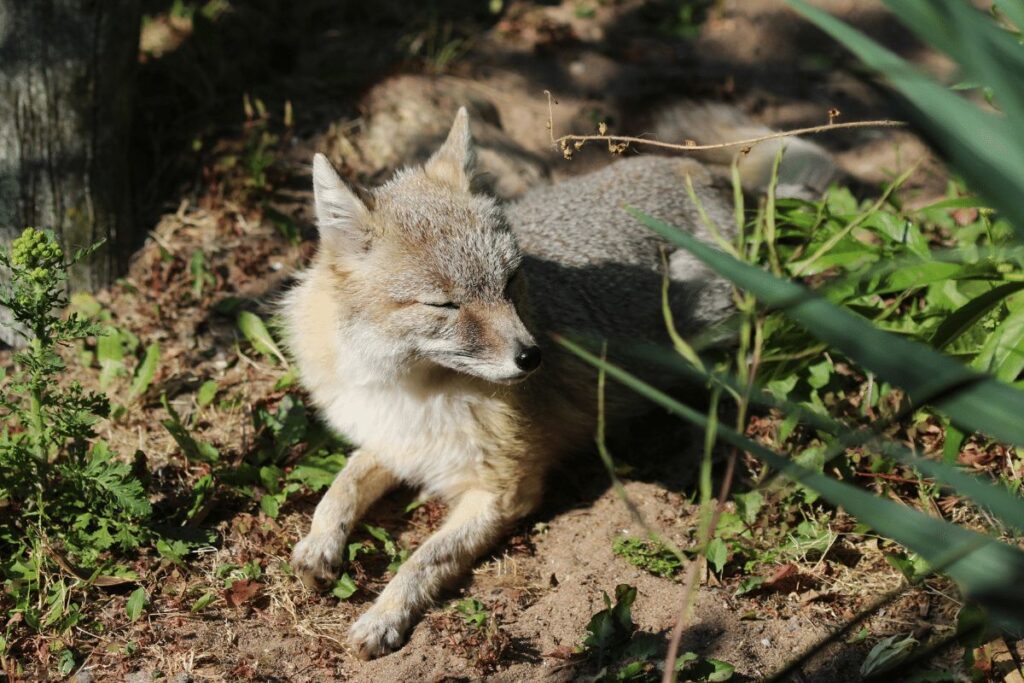
For those keen on observing these elusive creatures, a quiet stroll near Deer Haven, particularly during twilight hours, might offer a chance encounter. Their playful antics, which can range from chasing each other to engaging in mock skirmishes, are a joy to watch.
Yet, life in the Badlands isn’t without challenges for the swift fox. Predators, notably eagles and coyotes, are a constant threat. Their survival strategy hinges on their agility, and of course, the safety of their burrows.
Conservation stories tell us of a time when the swift fox’s numbers dwindled. But dedicated efforts, particularly within protected zones like the Badlands, have paved the way for a hopeful resurgence.
To spot a swift fox, then, isn’t just to witness a creature in its natural habitat; it’s to partake in a story of resilience and nature’s enduring dance of balance.
Black-footed ferrets
The black-footed ferret, often dubbed the “masked bandit” due to its distinctive facial markings, is a nocturnal wonder of the Badlands National Park.
A slender body, sharp features, and those characteristic dark legs make this creature unmistakable amidst the vast landscapes of the park. Yet, spotting one is a rare and thrilling experience, given their elusive nature and the conservation challenges they’ve faced.
Once considered extinct in the wild, these ferrets owe their presence in the Badlands to extensive conservation efforts. The park is now one of the few places in North America where these animals have been reintroduced and are thriving.
Residing primarily in prairie dog towns, the black-footed ferret has a diet heavily reliant on these rodents. They’re adept hunters, using their slender bodies to navigate the tunnels of prairie dog burrows, ambushing their prey with swift precision.
The Pinnacles area of the Badlands, known for its prairie dog populations, serves as a favored hunting ground for these ferrets.
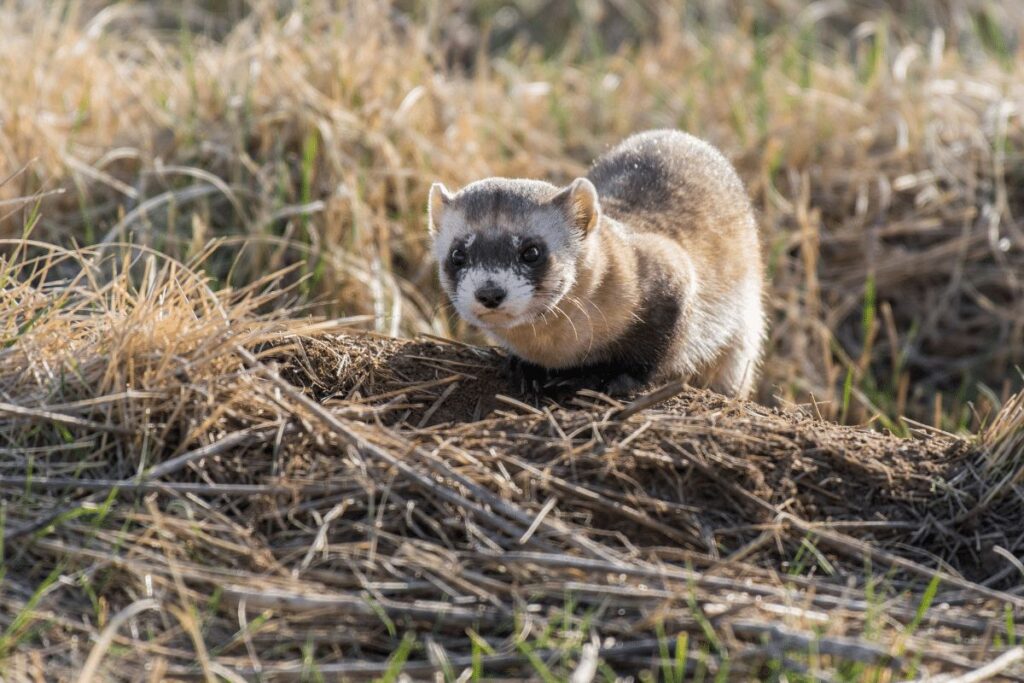
These creatures are most active during the night, and their large eyes are well-adapted to low light conditions, aiding them in spotting prey and evading predators. While prairie dogs are their primary diet, they won’t shy away from smaller mammals or birds if the opportunity arises.
The Conata Basin region of the Badlands is a particularly important habitat for black-footed ferrets. Here, they find an intricate network of burrows and a steady food source, making it a stronghold for their populations.
For those hoping to catch a glimpse, patience and a bit of luck are key. Night-time excursions, particularly around prairie dog towns, might offer the rare sight of a ferret peeking out from a burrow or stealthily navigating the grasslands in search of its next meal.
The story of the black-footed ferret in the Badlands is one of resilience and recovery. Their continued presence in the park is a testament to dedicated conservation efforts and a beacon of hope for endangered species everywhere.
Each sighting, each rustle in the grass, and each silhouette in the moonlight is a poignant reminder of nature’s ability to rebound and flourish.
Mountain lion
Mountain lions, also known as cougars or pumas, are the ghostly apex predators of the Badlands National Park. These creatures exude a blend of grace and power, with sleek bodies, piercing eyes, and a tail that often sways with a mesmerizing fluidity.
Their tawny coats provide an effective camouflage against the rocky terrains and grasslands of the park, often rendering them nearly invisible until they’re up close.
Though the Badlands isn’t their exclusive domain, certain parts of the park, especially its rugged canyons and dense vegetation patches, provide the solitude and cover these solitary cats prefer.
The Stronghold Unit and Palmer Creek area are among the regions where these elusive felines might be found, especially during dawn or dusk when they are most active.
Mountain lions are versatile predators, capable of taking down animals much larger than themselves. From mule deer to smaller mammals, their diet reflects their adaptability and prowess.
Their hunting style is one of stealth and ambush, using the natural contours of the land to stalk and surprise their prey.
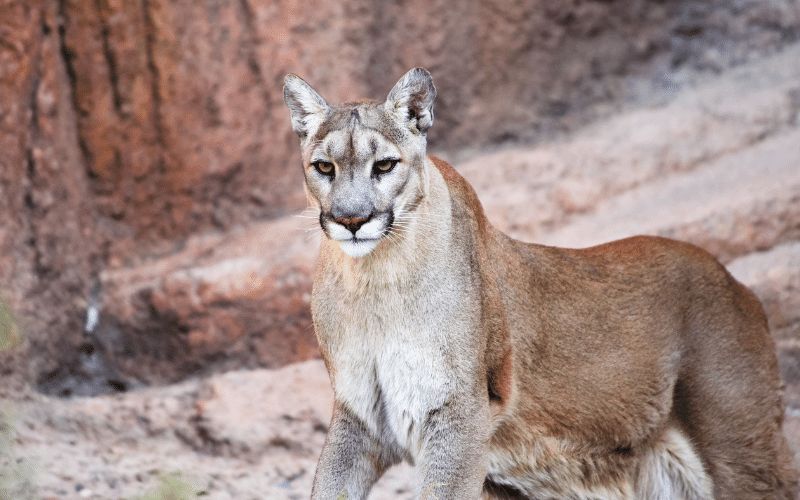
While their presence might evoke a sense of trepidation, encounters with humans are exceptionally rare. These cats are shy by nature and generally prefer to steer clear of human activity.
However, hikers are often advised to be vigilant, especially during the twilight hours, and to hike in groups, making enough noise to alert these creatures of human presence.
Despite being apex predators, mountain lions are not without challenges in the Badlands. They face threats from habitat fragmentation, potential conflict with humans, and sometimes competition with other predators for food sources.
The Cedar Pass region, with its mix of terrains and abundant prey, is another potential habitat for these magnificent cats.
Here, their presence has a cascading effect on the ecosystem, helping to keep herbivore populations in check and thus maintaining a balanced and thriving environment.
Witnessing a mountain lion in the Badlands, even if it’s just a fleeting glimpse, is an electrifying experience. It serves as a reminder of the wild, untamed spirit of nature and the intricate web of life that the park sustains and protects.
Their silent footfalls, the soft glint in their eyes, and their regal bearing all tell a story of survival, majesty, and the enduring mystique of the wild.
Golden eagles
Golden eagles, with their majestic wingspan and regal bearing, are one of the aerial marvels of Badlands National Park. These raptors, clothed in a rich brown plumage with golden highlights on their heads and necks, are a testament to the grandeur of the avian world.
Their sharp eyes, capable of spotting a hare or prairie dog from considerable heights, are a symbol of their impeccable hunting prowess.
Hovering above the park’s plateaus and canyons, these eagles often use the thermals to glide effortlessly, saving energy while patrolling their vast territories.
The skyward cliffs and rugged outcroppings in areas like the Pinnacles serve as ideal vantage points and nesting sites for these birds.
The diet of the golden eagle is varied. From small mammals like the swift fox or prairie dogs to larger prey like lambs or even young deer, their versatility as hunters is evident.
They are also known to scavenge when the opportunity presents itself, showcasing their adaptability to the environment and its offerings.
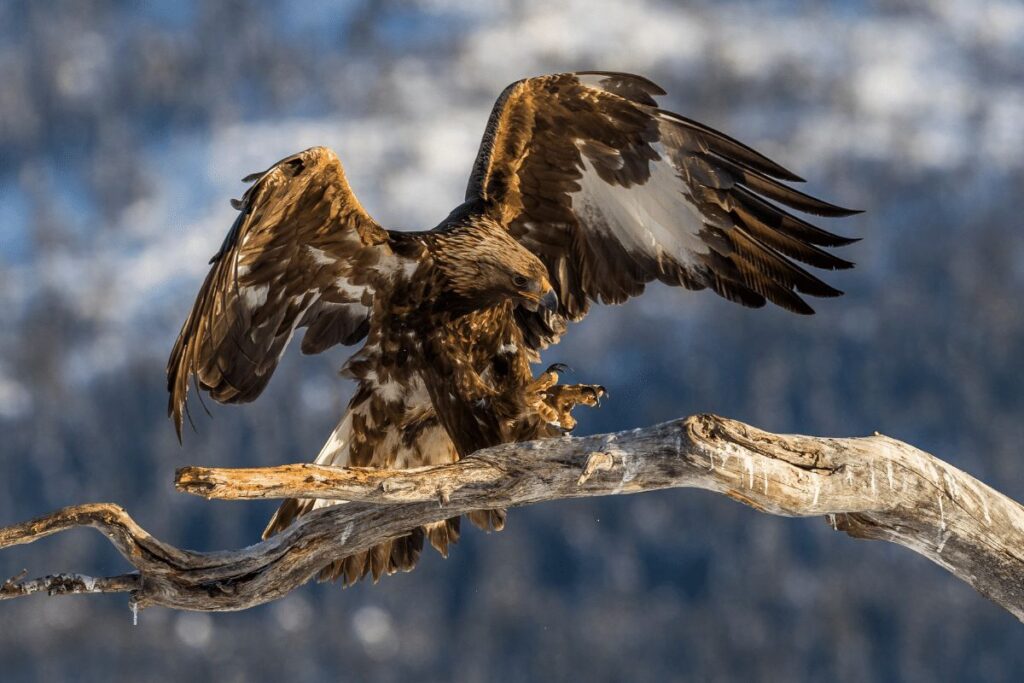
While soaring, golden eagles provide a sight to behold. Their methodical wing beats, interspersed with glides, are a masterclass in flight mechanics. The more open regions of the park, especially around Sage Creek, offer a panoramic backdrop against which these eagles often display their aerial acrobatics, from steep dives to chase prey to intricate mid-air maneuvers during courtship displays.
Despite their position atop the avian food chain, golden eagles face challenges. Habitat loss, disturbances during nesting periods, and the risk of poisoning from consuming prey tainted with pesticides are some of the threats these majestic birds grapple with.
The park’s expansive landscapes, especially regions like the Conata Basin, with its mix of grasslands and rocky outcrops, provide both hunting grounds and the solitude golden eagles prefer for nesting.
The sight of a golden eagle nest, often a large structure of sticks and vegetation, perched precariously on a cliff edge, is both awe-inspiring and a testament to nature’s engineering.
To witness a golden eagle in the Badlands, to hear its piercing call echo across the vastness, or to simply watch its silhouette against the setting sun, is to connect with the wild spirit of the park.
These moments are reminders of the fragile yet enduring beauty of nature and the intricate tapestry of life that Badlands National Park cradles within its boundaries.
Trails in Badlands National Park to See Wildlife
The sprawling landscapes of Badlands National Park are not only mesmerizing but also teem with wildlife. Some trails offer better opportunities than others to spot the park’s incredible inhabitants.
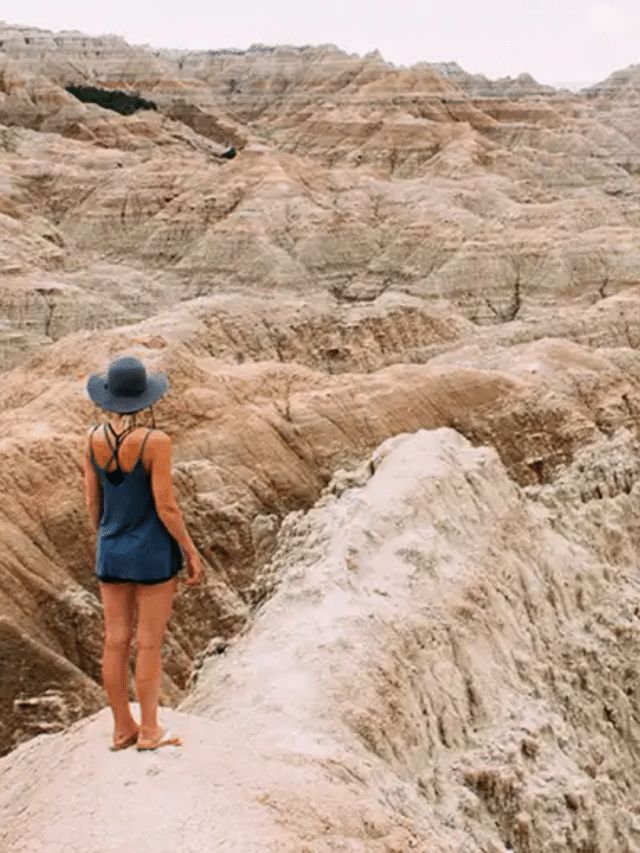
Here are a few that bring you face-to-face with the magic of nature:
- The Notch Trail: This moderate 1.5-mile round trip leads to a fantastic viewpoint. Along the way, keep an eye out for bighorn sheep gracefully navigating the rocky terrains and prairie dogs popping out of their burrows.
- Castle Trail: Stretching for 10 miles, this is the longest trail in the park. A good chunk of this trail meanders through open grasslands, offering opportunities to spot bison, pronghorn, and mule deer.
- Saddle Pass Trail: A short but steep trail, it’s known for sightings of swift foxes, especially during dawn and dusk when they are most active.
- Window Trail: This easy 0.25-mile trail provides a unique vantage point to observe birds, especially the magnificent golden eagles, circling overhead or resting atop the spires.
- Cliff Shelf Nature Trail: An excellent trail for beginners, this half-mile loop boardwalk often rewards hikers with glimpses of black-footed ferrets and the occasional mountain lion.
- Fossil Exhibit Trail: While this trail is more famed for its geologic displays, don’t be surprised to find herds of elk grazing nearby, especially during the cooler hours.
When exploring these trails, remember to keep a safe distance from wildlife. It’s always best to observe with binoculars or a camera lens. The park’s animals are wild and can be unpredictable.
Treading lightly and respecting their space ensures a safe and memorable experience for all.
Also Read: 7 BEST HIKES IN BADLANDS NATIONAL PARK WE GO ON EVERY YEAR!
Conclusion
Visiting Badlands National Park was truly an amazing experience. We are so glad we made the effort to visit and explore this unique environment, full of incredible wildlife. From bison to eagles, it was a delight to witness such majestic animals in their natural habitat. Thank you for reading about our journey through Badlands National Park and we hope that this article has helped inspire your own exploration of the park’s wonders!

